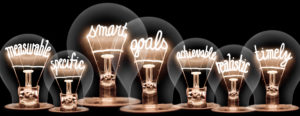In the world of sales and operations planning (S&OP), two methods reign supreme. The planning process has to start somewhere, and that somewhere is usually either the top or the bottom of the organization’s employee hierarchy, or everywhere all at once.
If you’ve ever wondered whether top-down planning, bottom-up planning or countercurrent planning is right for your organization, this is the post for you.
Get ready – we’re throwing the three most commonly used S&OP methods into the battle ring.
Contender #1: What is Top-down Planning?
Top-down planning starts by establishing global strategies and objectives and determining a path toward achieving them. These objectives are general, growing more specific as they move down the hierarchical ladder. Also known as retrograde planning, this approach requires management to create a framework out of pre-existing company goals, market research and growth targets.
Pros
The major advantage of top-down planning is the guaranteed alignment with corporate goals. Sub-plans are created directly from corporate objectives. This reduces the amount of coordination involved, which allows plans to be made faster with less headache.
It also helps that objectives and expectations come from one source, rather than from multiple convoluted voices. Middle management can act quickly using direct orders, without trudging through multiple levels of decision-making. This simplifies the delegation of tasks to employees lower on the ladder.
Cons
Determining the structure, systems, capacities, etc. for departments across the entire organization is no simple task. Because upper management is so far removed from the inner workings of these departments, their targets can end up being unrealistic or unattainable.
Taking the planning power away from individual departments can also limit creativity, prevent collaborative decision-making and drop morale. Worst case scenario, it impacts a team’s output and hinders their progress.
Contender #2: What is Bottom-up Planning?
Bottom-up planning is often chosen by companies aiming to diversify decision-making in an inclusive environment. It makes S&OP collaborative, allowing the entire organization to set goals and impact the direction operations take.
The process starts with lower levels of the organizational hierarchy setting narrow goals, which are gradually integrated into the framework of the global goals and strategy of the hierarchy’s upper levels. This is a progressive approach.
Teams are created based on expertise. These teams follow their own approach, completing tasks without adhering to a rigid set of corporate strategies. This progressive planning method often focuses on developing specific services or products for a specific location.
Pros
In bottom-up planning, employees initiate the planning process. This gives strategic power to the voices working closely with your customers. Lower-level employees’ voices have weight. They feel connected to the company’s overarching goals, which results in higher morale, motivation and productivity.
Because plans are built from the ground up, they fit seamlessly into the team’s processes and carry an inherent understanding of the customer journey. These plans are both realistic and in tune with the market.
Cons
When plans aren’t coming from one source, they take significantly more effort to coordinate. Ensuring all the plans align (and none contradict) takes time and highly efficient communication.
The true downfall of bottom-up planning is when there are too many cooks in the kitchen. Competing voices can prolong decision-making, waste time, and impede productivity without a single project manager. This is especially harmful if the team members are not devoted to the organization’s success as a whole.
Top-down Planning vs Bottom-up Planning
Top-down planning defines corporate goals, then divides them into specific goals to be tackled in phases. This is a retrograde planning approach. The ultimate goal is for the planning to slowly shift down the hierarchical ladder. Management creates a framework plan with company goals. That framework is divided into subgoals, which are then implemented at the lowest levels of planning.
Bottom-up planning, on the other hand, is a progressive planning approach that initiates the plan at the lowest level, then develops it as it climbs the hierarchical ladder. Bottom-up planning is created based on the company’s specific products or services, sales forecast data and information like production capacity, costs from each department and the assessment of market trends.
Contender #3: What is Countercurrent Planning?
Countercurrent planning utilizes both methods simultaneously. The result is an efficient, target-oriented implementation of company goals that include all affected departments and processes.
How does countercurrent planning work?
Instead of starting with the top or the bottom of the hierarchy, countercurrent creates plans based on the interactions between management (the top) and operational levels (the bottom). This starts with top-down preparation. Management levels create a preliminary framework based on data from previous bottom-up forecasts. After this, the middle of the hierarchy takes that framework and uses it to create sub-plans for individual departments. The bottom of the hierarchy then coordinates and summarizes the sub-plans. Corporate management will then approve corporate plans and objectives based on the information gathered.
Countercurrent planning requires more coordination effort than the other options. Because changes by the lower levels have to be approved by management, slowdowns may occur. Despite these potential disadvantages, countercurrent planning retains the best qualities of both the top-down and bottom-up planning methods.
It ensures all strategic goals and objectives align, creates more realistic, achievable objectives and makes objectives relatable for employees at all levels of the organization.
So, What’s the Best S&OP Method?
At the end of the day, the winner of this battle depends on the rules of the game. Every company has a different set of resources, employee hierarchy, workflow and desired outcome.
If your company wants to improve product development or services through innovation and creativity, bottom-up planning is the way to go. If your company values speed and efficiency over creativity, top-down planning can get you there without the need for cumbersome collaboration processes. On a tight budget? Starting from the bottom is the most effective at creating accurate financial projections.
Companies that have time for extra collaboration and want the best of both worlds – aligned, realistic plans driven by creativity and innovation – should opt for the countercurrent approach.
Whatever planning method you choose, Arkieva’s S&OP management tools can help. Schedule a demo to find out how our cross-functional, integrated planning solutions can take your organization to the next level.







